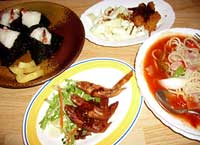|
|
|||||||
|
|
|||||||
|
|||||||
| | Web Japan >> | Trends in Japan >> | Lifestyle >> | The Tastes of Nagoya | |
|
THE TASTES OF NAGOYA Cuisine of Central Japan Finds Favor Nationwide (July 19, 2005) Nagoyan food is enjoying explosive popularity in Tokyo and other parts of Japan. Restaurants serving cuisine from Aichi Prefecture have made inroads in the capital, attracting diners with distinctively Nagoyan fare and further fueling interest in the region, which has recently been a focus of attention as the home of the newly opened Central Japan International Airport (Centrair) and as the host of EXPO 2005 Aichi, Japan. The Top Three Nagoyan Dishes The second most popular dish is misokatsu, a deep-fried pork cutlet with a sauce made from red miso, which is a local specialty. The crispy breadcrumb coating of the cutlet and savory sauce go perfectly with white rice. The number three favorite is miso nikomi udon, a one-pot dish in which thick, chewy udon noodles are cooked in a soup made from a variety of misos, most notably the savory, brown colored hatcho miso, which is a product of Okazaki City in Aichi Prefecture. Nagoya is also home to ankake supa, a dish of thick noodles topped by a thick, robust sauce; tebasaki karaage, or deep-fried chicken wings seasoned with pepper and garlic powder; and tenmusu, or rice balls containing shrimp tempura. These diverse dishes have one thing in common - a full, hearty flavor. Despite its powerful, distinctive character, Nagoyan food is attracting a loyal following around Japan, and Nagoyan restaurants in Tokyo are filled with patrons who say that they can't get enough. Nagoyan Restaurants Thrive Yabaton, a restaurant in Nagoya famous for its misokatsu, opened an outlet in Ginza in March 2004. The restaurant has enjoyed resounding success since it opened, with the number of patrons rising steadily. Ichibanya, which runs the popular ankake supa chain Pasuta de Koko, opened its first shop in the Toranomon business district of Tokyo in 2003 and its second shop in Suehirocho in 2004. Here, too, many diners are regulars. Esuwai Food, which operates a popular chain of izakaya (Japanese-style taverns or pubs) called Sekai no Yamachan that serve deep-fried chicken wings, established a restaurant in Tokyo after a successful venture in Kawasaki, Kanagawa Prefecture. It now has six shops in Tokyo. Its Seibu Shinjuku shop can seat as many as 250 people, and sales there are said to be on the order of ¥1 million ($9,091 at ¥110 to the dollar) a day. The company plans to open six or seven shops a year that feature distinctively Nagoyan dishes. With so many distinctive, delicious dishes in its repertoire, Nagoyan food is all set to continue gaining fans all across Japan. Copyright (c) 2005 Web Japan. Edited by Japan Echo Inc. based on domestic Japanese news sources. Articles presented here are offered for reference purposes and do not necessarily represent the policy or views of the Japanese Government. |
WHAT PLACES WOULD YOU RECOMMEND TO FOREIGN TOURISTS? (April 15, 2004) |
|
|



